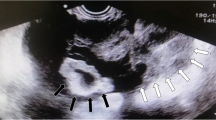Abstract
Human gonadotropins are widely used for induction of ovulation in the treatment of anovulatory infertility and for induction of multiple follicular development (MFD) in in vitro fertilization (IVF), gamete intrafallopian transfer (GIFT), and artificial insemination with husband’s semen (AIH) programs. Reported is a patient with normal menstrual cycles, who had two episodes of gonadal unresponsiveness to human gonadotropin therapy, followed by transient hypergonadotropic amenorrhea (“resistant ovary” syndrome), during induction of MFD in conjunction with AIH as treatment for unexplained infertility. The first episode occurred during the sixth cycle of a first series of MFD induction with daily intramuscular injections of exogenous gonadotropins. The second episode occurred during the second cycle of a second series of MFD induction with intravenous pulsatile administration of FSH. On both occasions, normalization of endogenous gonadotropin levels and reappearance of ovulatory cycles occurred spontaneously, after two and three months, respectively. A similar mechanism could occur in the failures of MFD induction observed in IVF programs.
Similar content being viewed by others
References
Rebar R.W., Silva de Sa’ M.F. The reproductive age: premature ovarian failure. In: Serra G.B. (Ed.), The Ovary. Raven Press, New York, 1983, p. 241
Shapiro A.G., Rubin A. Spontaneous pregnancy in association with hypergonadotropic ovarian failure. Fertil. Steril. 28: 500, 1977.
Wright C.S.W., Jacobs H.S. Spontaneous pregnancy in patients with hypergonadotropic ovarian failure. Br. J. Obstet. Gynecol. 86: 389, 1979.
Schwarts M., Jewelewicz R. The use of gonadotropins for induction of ovulation. Fertil. Steril. 35: 3, 1981.
Wood C., Mc Master R., Rennie G., Trounson A., Leeton J. Factors influencing pregnancy rates following in vitro fertilization and embryo transfer. Fertil. Steril. 43: 245, 1985.
Melis G.B., Paoletti A.M., Strigini F., Menchini Fabris F., Fioretti P. Induction of multiple follicular development to improve the pregnancy rates of artificial insemination with husband’s semen (AIH). In: Ratnam S.S., Teoh E.S., Ng S.C. (Eds.) In vitro fertilization and other alternative methods of conception. The Parthenon Publishing Group, Park Ridge, 1987, vol.2, p. 115.
Melis G.B., Paoletti A.M., Strigini F., Menchini Fabris F., Canale D., Fioretti P. Pharmacologic induction of multiple follicular development improves the success rate of artificial insemination with husband’s semen in couples with male-related or unexplained infertility. Fertil. Steril. 47: 441, 1987.
Melis G.B., Strigini F., Paoletti A.M., Fioretti P. AIH after induction of multiple ovulation. Fertil Steril. 49: 380, 1988.
Fioretti P., Paoletti A.M., Strigini F., Mais V., Olivieri L., Melis G.B. Induction of multiple follicular development as a therapy for unexplained or male-related infertility. Gynecol. Endocrinol. 3: 45, 1989.
Spitz I., Bell J., Arod G., Benveniste R., Rabinowitz D. Development of anti-human FSH antibody in a patient with isolated FSH deficiency. J. Clin. Endocrinol. Metab. 36: 684, 1973.
Healy D.L., Fraser I.S., Lee V.W.K., Shearman R.P., Burger H.G. Characteristics of an antiluteinizing hormone isoantibody produced during gonadotropin induction of ovulation. J. Clin. Endocrinol. Metab. 47: 823, 1978.
Sokol R.Z., McClure R.D., Peterson M., Swerdloff R.S. Gonadotropin therapy failure secondary to human chorionic gonadotropin-induced antibodies. J. Clin. Endocrinol. Metab. 52: 929, 1981.
Nakamura Y., Yoshimura Y., Tanabe K., lizuka R. Induction of ovulation with pulsatile subcutaneous administration of human menopausal gonadotropin in anovulatory infertile women. Fertil. Steril. 46: 46, 1986.
Lenton E.A., Burton R.M., Cooke I.D. Acute menopausal transition associated with clomiphene therapy: two cases reports. Br. J. Obstet. Gynecol. 86: 238, 1979.
Yen S.S.C. Clinical applications of gonadotropin-releasing hormone and gonadotropin-releasing hormone analogs Fertil. Steril. 39: 257, 1983.
Cameron I.T., O’Shea F.C., Rolland J.M., Hughes E.G., de Kretser D.M., Healy D.L. Occult ovarian failure: a syndrome of infertility, regular menses, and elevated follicle-stimulating hormone concentrations. J. Clin. Endocrinol. Metab. 67: 1190, 1988.
Author information
Authors and Affiliations
Rights and permissions
About this article
Cite this article
Mais, V., Melis, G.B., Antinori, D. et al. Repeated transient hypergonadotropic amenorrhea during pharmacologic induction of multiple follicular development with exogenous gonadotropins. J Endocrinol Invest 13, 749–752 (1990). https://doi.org/10.1007/BF03349615
Received:
Accepted:
Published:
Issue Date:
DOI: https://doi.org/10.1007/BF03349615




